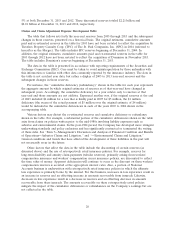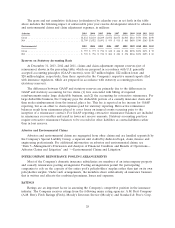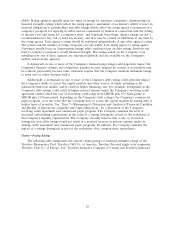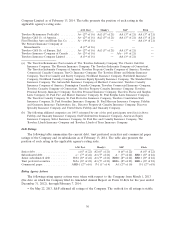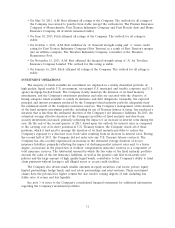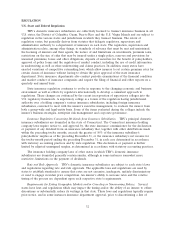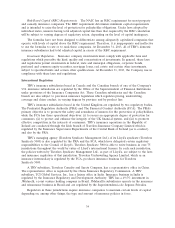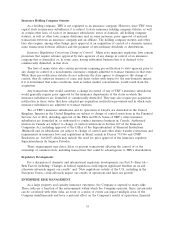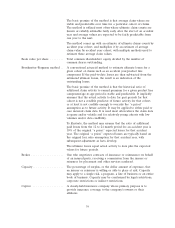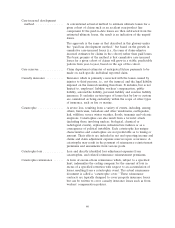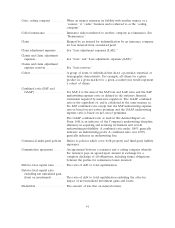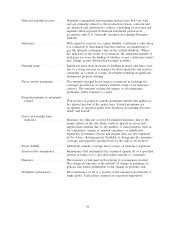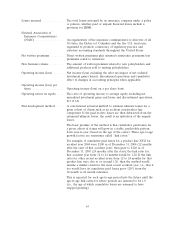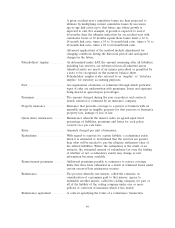Travelers 2013 Annual Report Download - page 46
Download and view the complete annual report
Please find page 46 of the 2013 Travelers annual report below. You can navigate through the pages in the report by either clicking on the pages listed below, or by using the keyword search tool below to find specific information within the annual report.position and/or liquidity. These exposures require an entity-wide view of risk and an understanding of
the potential impact on all aspects of the Company’s operations. It also requires the Company to
manage its risk-taking to be within its risk appetite in a prudent and balanced effort to create and
preserve value for all of the Company’s stakeholders. This approach to Company-wide risk evaluation
and management is commonly called Enterprise Risk Management (ERM). ERM activities involve
both the identification and assessment of a broad range of risks and the execution of synchronized
strategies to effectively manage such risks. Effective ERM also includes the determination of the
Company’s risk capital needs, which takes into account regulatory requirements and credit rating
considerations, in addition to economic and other factors.
ERM at the Company is an integral part of its business operations. All risk owners across all
functions, all corporate leaders and the board of directors are engaged in ERM. ERM involves
risk-based analytics, as well as reporting and feedback throughout the enterprise in support of the
Company’s long-term financial strategies and objectives.
The Company uses various methods, including proprietary and third-party computer modeling
processes, to continually monitor and analyze catastrophic events and the risks associated with them.
These analyses and methods are used in making underwriting and reinsurance decisions as part of
managing the Company’s exposure to catastrophic events. In addition to catastrophe modeling and
analysis, the Company also models and analyzes its exposure to other extreme events. The Company
also utilizes proprietary and third-party computer modeling processes to evaluate capital adequacy.
These analytical techniques are an integral component of the Company’s ERM process and further
support the Company’s long-term financial strategies and objectives.
In addition to the day-to-day ERM activities within the Company’s business units, other key
internal risk management functions include the Management and Operating Committees (comprised of
the Company’s Chief Executive Officer and the other most senior members of management), the
Enterprise and Underwriting Risk Committees of management, the Credit Committee, the Chief
Compliance Officer, the Corporate Actuarial group, the Corporate Audit group, the Accounting Policy
group, the Enterprise Underwriting group and many others. A senior executive oversees the ERM
process. The mission of this executive is to facilitate risk assessment and to collaborate in implementing
effective risk management strategies throughout the Company. Another strategic ERM objective of this
executive includes working across the Company to enhance effective and realistic risk modeling
capabilities as part of the Company’s overall effort to understand and manage its portfolio of risks to
be within its risk appetite. Board oversight of ERM is provided by the Risk Committee of the board of
directors, which reviews the strategies, processes and controls pertaining to the Company’s insurance
operations and oversees the implementation, execution and performance of the Company’s ERM
program.
The Company’s ERM efforts build upon the foundation of an effective internal control
environment. ERM expands the internal control objectives of effective and efficient operations, reliable
financial reporting and compliance with applicable laws and regulations, to fostering, leading and
supporting an integrated, risk-based culture within the Company that focuses on value creation and
preservation. However, the Company can provide only reasonable, not absolute, assurance that these
objectives will be met. Further, the design of any risk management or control system must reflect the
fact that there are resource constraints, and the benefits must be considered relative to their costs. As a
result, the possibility of material financial loss remains in spite of the Company’s significant ERM
efforts. An investor should carefully consider the risks and all of the other information set forth in this
annual report, including the discussions included in ‘‘Item 1A—Risk Factors,’’ ‘‘Item 7A—Quantitative
and Qualitative Disclosures About Market Risk,’’ and ‘‘Item 8—Financial Statements and
Supplementary Data.’’
36


